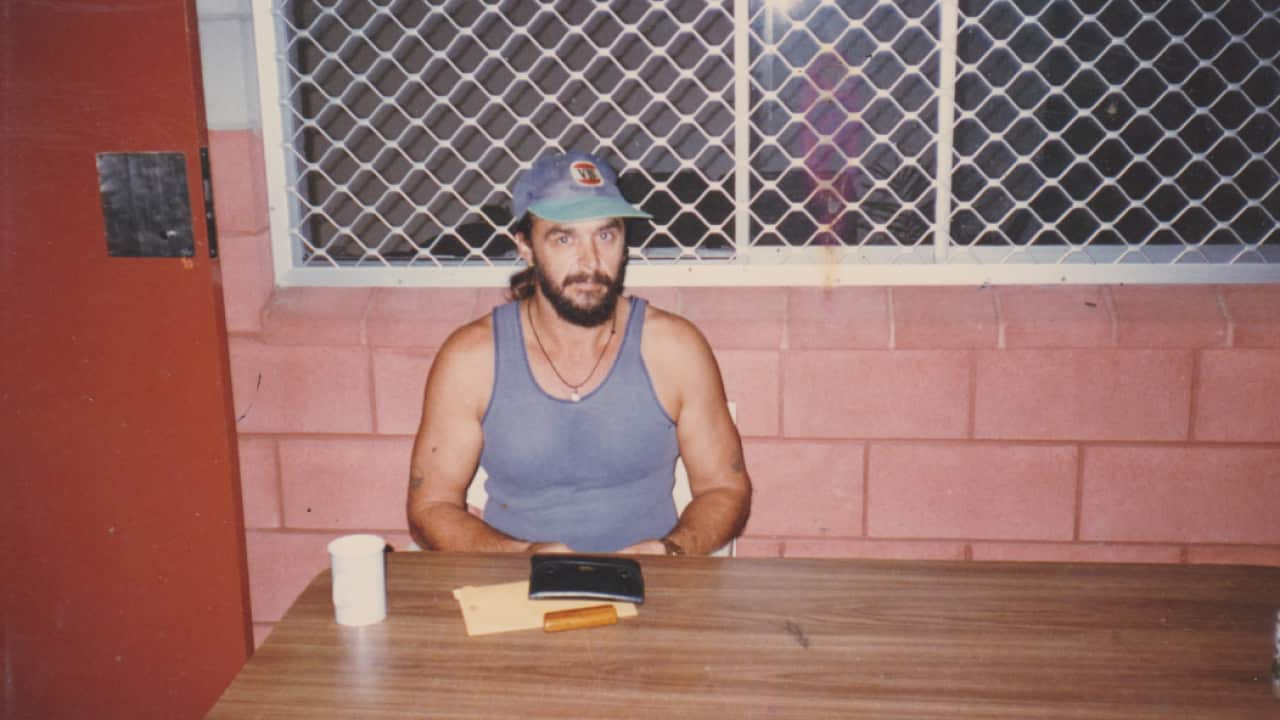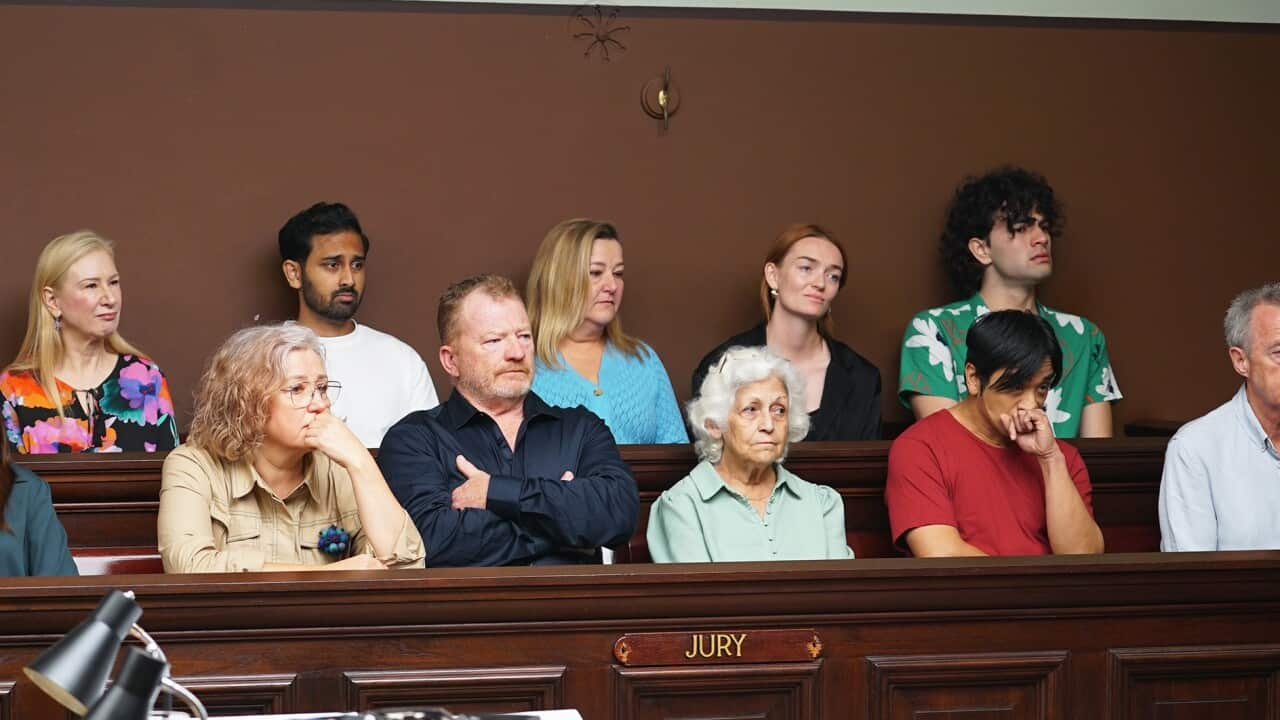This article contains spoilers.
The appearance of Philip Leung on the finale of SBS' reality show The Jury brought many on the 12-person panel to tears.
The Jury: Death on the Staircase reveals the deliberations of a panel of everyday Australians asked to consider the evidence of a real-life manslaughter trial.
Actors recreated the trial of Leung, who faced court three times in NSW for the manslaughter of his partner Mario Guzzetti in 2007.
In the final episode, Leung appeared in a video message following the mock jury's delivery of a not-guilty verdict.

Members of SBS show The Jury heard from the real-life accused Philip Leung during the final episode. Source: SBS News
"Terrible things happened," says Leung of the two years he spent in jail before his conviction was overturned on appeal, adding that he had contemplated killing himself.
Leung cried as he reflected on how "wonderful" it would be if Mario was still alive.
"I'm trying to be strong," he says.
Panel delivers verdict on The Jury
The SBS show recreated transcripts and evidence from Leung's real-life manslaughter trial.
Leung is played by actor Sky Dominic and his name has been changed to Shaun Yang in the show.
In the last episode, the panel's deliberations show how they confronted their personal prejudices and biases to deliver a not-guilty verdict.
Initially, three members of the panel believed Shaun was guilty of manslaughter over his partner Carlo Levetto's death, while nine thought he was not guilty.
After hours of discussion, two panellists were eventually convinced to change their vote, conceding they had "reasonable doubt" because they could not rule out another explanation for the death.
The remaining person on the panel also agreed to vote with the others but later said he still thought Shaun was guilty.
The appearance of Leung — the real-life Shaun — in a recorded video moved many on the panel and reinforced the idea they had made the right decision.
One of the panel members who was convinced to change his vote said "We got it right", while another noted it was "hard work" to get everyone to agree.
"That poor man," says one juror after hearing from Leung.
The real-life story behind The Jury staircase murder
Philip Leung was 46 years old when his long-term partner Mario Guzzetti — then 71 — was found dead at the bottom of the staircase in their Sydney terrace on the morning of 7 April 2007.
An autopsy found blunt-force injury to Guzzetti's head and neck, which could have been caused by someone striking him, or by him hitting a wall or staircase.
Leung was put on trial in 2009 for murder and manslaughter but was acquitted on both charges after Justice Stephen Rothman concluded there was insufficient evidence and directed the jury to deliver a not-guilty verdict.
Two years later the Crown used double jeopardy laws introduced in 2006 to retry him for manslaughter. The laws allow the NSW Office of the Director of Public Prosecutions to appeal verdicts directed by a judge.
"This occurred at a time when they needed a case. This piece of legislation of double jeopardy that allowed Leung to be treated like this was completely unnecessary and a typical knee-jerk reaction of politicians."

Philip Leung leaves the NSW Supreme Court in Sydney on 20 April 2009. Source: AAP / Dean Lewins
But Leung's victory did not last long. Just a year later, he became the first man in NSW history to be tried three times for a homicide, after the NSW Court of Criminal Appeal quashed his acquittal and ordered a new trial in 2012.
In his third trial, Leung was found guilty of manslaughter by a jury and sentenced to a minimum of four-and-a-half years in jail.
"The jury was satisfied beyond reasonable doubt that following an argument with the deceased, when the offender had been making carrot juice, the offender in anger attacked him and caused his death and that the offender's acts were deliberate, unlawful and dangerous," Judge Derek Price noted during sentencing.
But Leung was released two years later after a successful appeal. Justices Elizabeth Fullerton and Christine Adamson ruled the evidence presented at trial was insufficient to convict Leung beyond reasonable doubt.

Philip Leung was interviewed by SBS in 2016. Source: SBS News / Damien Pleming
Evidence was insufficient
The Crown's evidence centred on the idea that Leung either strangled Guzzetti or hit him over the head, possibly with part of a juicer found near his body.
Fullerton said the absence of blood under the juicer or on the floor around it was significant and did not support the suggestion that it had been used to strike or beat Guzzetti.
Guzzetti also had hypertension, scarring of the liver, fluid in his lungs, an enlarged heart and three partly blocked arteries.
"In the trial, they said the heart was enlarged. I really think it was something to do with the heart," Leung told shortly after he was released from jail.
"He had high blood pressure. Also, he was 71. Even if you are very healthy, you are 71."
Before his first trial in 2009, Leung says he was offered a deal of manslaughter in exchange for a guilty plea but he refused, telling SBS: "I didn't do it".
'Big personalities' can influence decisions
University of Newcastle associate professor of criminology Dr Xanthé Mallett says The Jury highlights how everyone who sits on a jury brings prejudices and preconceived notions to the experience.
"I think that's just human nature and that's part of the process and part of the system," she tells SBS News.
"That's just something we have to accept — I can't think of a better way of doing it."
Mallett says it was fascinating to watch how some people on the show were persuaded to change their vote.
You have some very big personalities that can persuade other personalities to go with their line of thinking.
This is just one of the factors that can influence outcomes and part of the reason why Mallett — whose opinions as a forensic expert may be weighted more highly than others — is not allowed to sit on a jury herself.
"We have checks and balances in place to prevent [empanelling] those who could obviously have an undue influence on others," she says.
But Mallett says she doesn't think it would be a good idea to restrict certain personalities because a jury is meant to be a random cross-section of the population.

Members of The Jury panel sat through evidence taken from a real-life trial. Source: SBS News
Juries take their role seriously
In real life, Leung was convicted by a jury during this third trial, while the panel on The Jury found him not guilty.
Mallett says despite efforts to portray the evidence in the same way on the show, it can't match the original trial exactly.
"We can't say what would have happened if these particular 12 people had sat through that actual jury trial."
But she says what will give people comfort is the seriousness with which those on the panel took their role, even though it's a simulated jury.
"You could tell from the outcome — when they were introduced to [Leung] — they were really moved. They were trying to reach the correct outcome," Mallett says.
"From what I have heard of genuine jury trials ... they do take it seriously, they don't make flippant decisions.
"Generally I think juries do get it right."
'As close as we can get to jury research in Australia'
Mallett says unlike in other countries, researchers in Australia aren't allowed to interview juries to find out how they made their decision.
"You can never predict what a jury is going to do: I've seen many cases where you think you're sure [about their decision] and then you're surprised."
While Mallett says it would be valuable to understand those dynamics, seeing the deliberations on The Jury is as close as they can get.
It's a frustration to me that we can't do more jury research in this country to try and understand what happens behind those closed doors.
She says it was surprising to see how heated the discussions in the jury room became, and for jury members initially intending to vote guilty to feel so isolated and attacked.
"It got quite adversarial in the jury room and I wasn't quite sure they were going to reach a unanimous verdict.
"It was a fascinating series and as close as we can get to genuine jury research in this country."
is available to stream free on SBS On Demand. An encore of the final episode will air on Saturday at 8.30pm.





